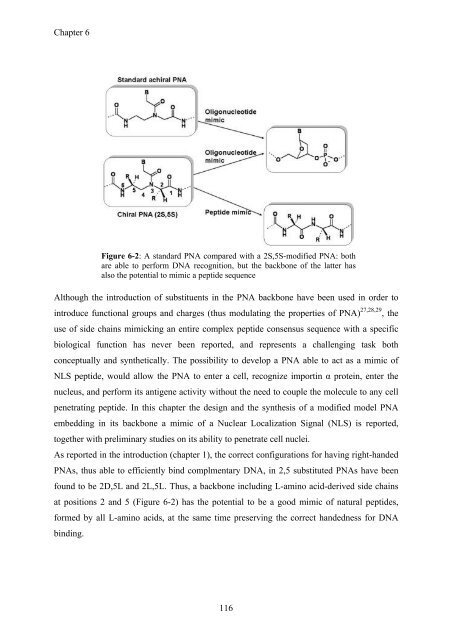View - DSpace UniPR
View - DSpace UniPR
View - DSpace UniPR
You also want an ePaper? Increase the reach of your titles
YUMPU automatically turns print PDFs into web optimized ePapers that Google loves.
Chapter 6<br />
Figure 6-2: A standard PNA compared with a 2S,5S-modified PNA: both<br />
are able to perform DNA recognition, but the backbone of the latter has<br />
also the potential to mimic a peptide sequence<br />
Although the introduction of substituents in the PNA backbone have been used in order to<br />
introduce functional groups and charges (thus modulating the properties of PNA) 27,28,29 , the<br />
use of side chains mimicking an entire complex peptide consensus sequence with a specific<br />
biological function has never been reported, and represents a challenging task both<br />
conceptually and synthetically. The possibility to develop a PNA able to act as a mimic of<br />
NLS peptide, would allow the PNA to enter a cell, recognize importin α protein, enter the<br />
nucleus, and perform its antigene activity without the need to couple the molecule to any cell<br />
penetrating peptide. In this chapter the design and the synthesis of a modified model PNA<br />
embedding in its backbone a mimic of a Nuclear Localization Signal (NLS) is reported,<br />
together with preliminary studies on its ability to penetrate cell nuclei.<br />
As reported in the introduction (chapter 1), the correct configurations for having right-handed<br />
PNAs, thus able to efficiently bind complmentary DNA, in 2,5 substituted PNAs have been<br />
found to be 2D,5L and 2L,5L. Thus, a backbone including L-amino acid-derived side chains<br />
at positions 2 and 5 (Figure 6-2) has the potential to be a good mimic of natural peptides,<br />
formed by all L-amino acids, at the same time preserving the correct handedness for DNA<br />
binding.<br />
116
















